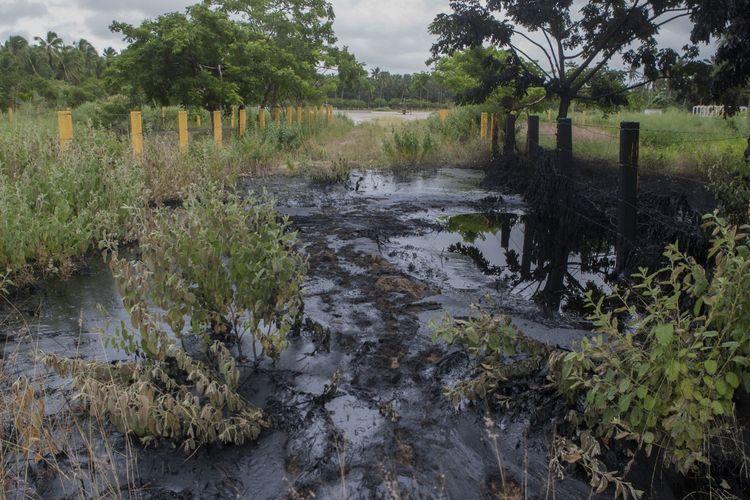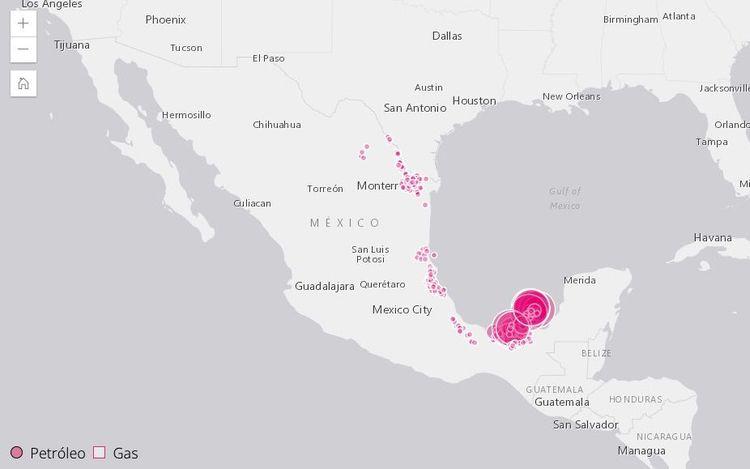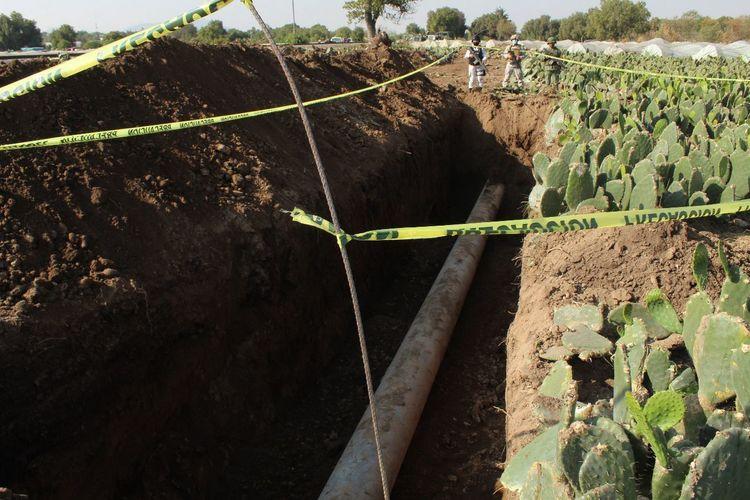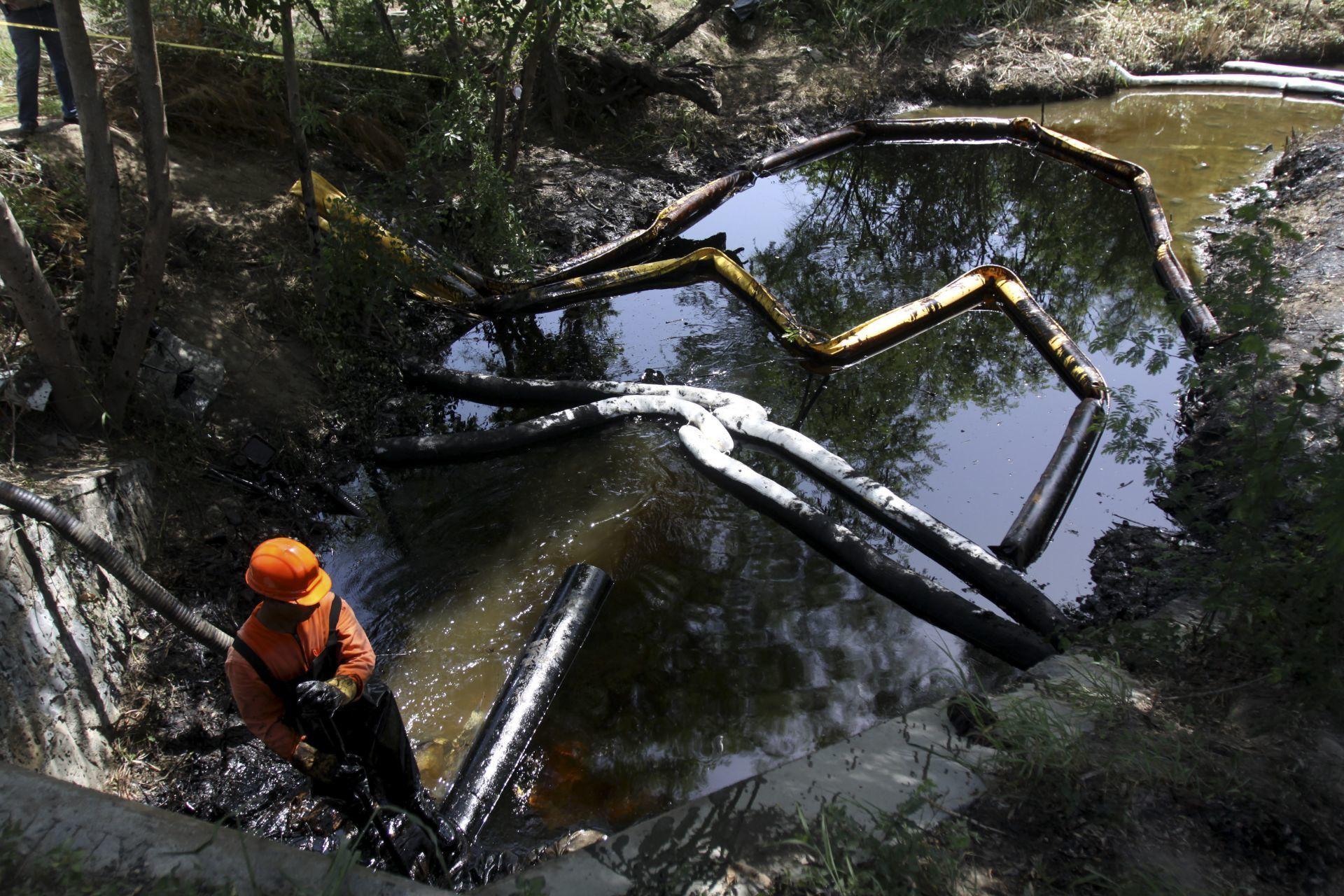From 2018 to 2021, Petrleos Mexicanos (Pemex) recorded 176 spills and leaks on a moderate and severe scale. Substances such as crude oil, oil and gasoline have been dumped into soils, rivers and seas, mainly due to industrial failures and vandalism, where Tabasco and Veracruz account for 63% of the disasters, according to information provided through transparency to Journalism Causa Natura.
In the municipalities of Comalcalco and Paraíso, Tabasco, less than half an hour from the coast of the Gulf of Mexico and the construction area of the Dos Bocas refinery, Pemex leaks and spills are as common as oil activity in the region.
The former occur as discharges of liquid or solid pollutants into soil and water. While the latter come from fluids or gases that, due to alterations, leak from a pipe or container that regularly escape into the atmosphere.
“If it's not because of huachicol, it's because of the lack of maintenance of the Pemex facilities,” said José, a native of Comalcalco and a maneuver on platforms for drilling oil wells.
His last job was on Cantarell II, one of the four platforms of Grupo R in Tabasco, the firm founded in 1960 and which in this federal administration is one of the main contractors of Pemex Exploration and Production (PEP).
For this publication, José asked not to reveal his name due to labor disputes against the company for lack of payments and liquidation after the six years he worked exploring around 12 wells, he said.
“In addition to low maintenance, sometimes companies have to work under the time that Pemex gives, if they tell you that you have to finish by tomorrow, it's for tomorrow, so if there were leaks you wouldn't stop... Many times I had to see how they threw oil cement into the sea, mostly at night and early morning,” he said in an interview.
Journalism Causa Natura sought Grupo R's version of the allegations of spills and leaks, as well as the exploration of wells, however, until the close of the edition of this publication, no response was obtained.
In the account, José mentioned that spills and leaks are not only in seas or rivers due to the activities of oil platforms, they also occur on land when there are infrastructure failures, such as pipeline ruptures.
“People no longer harvest because of the pollution that exists, even the cattle pasture is dead, there is no business anymore, everyone is (working) on the Dos Bocas refinery works,” he added.
In June 2020, the Patastal Tercera Sección community, Comalcalco, reported oil spills on more than 10 hectares of different lands. And in the last three years, local media have documented damage to the fishing areas of the municipalities of Paraíso and Cárdenas.
At the national level, of the 176 reports made at the Pemex Emergency Coordination and Support Center (CCAE) from 2018 to 2021, 156 were spills and 20 were related to leaks.
In the case of the former, 148 were poured into soil and 8 into water, mainly hydrocarbon derivatives. While of the total number of leaks, 19 were caused by gas to the atmosphere and one to water.
The volume of spills in the same period is 734.85 barrels. If we consider that each barrel can hold an average of 159 liters, this would be equivalent to more than 116 thousand liters discharged during this time. As for leaks, the estimate is 0.60 million cubic feet.
In most of the incidents, the subsidiary in charge was Pemex Exploration and Production with 112; followed by Pemex Logistics (PLOG) with 27; and Pemex Industrial Transformation (TRI) with 37.
In addition, the numbers are increasing. In 2018, there were 34 spills and leaks; in 2019 it rose to 50; in 2020 it decreased to 35; until 2021, which surpassed previous years with 57.
“There are also spills that occur on a microscale, which are very little noticed... they are like the engines of boats, the oils thrown away by ships, they are small leaks and we understand very little about that, there is no news about that,” said Daniel Pech, head of the Marine Biodiversity and Climate Change Laboratory of the Colegio de la Frontera Sur (Ecosur) in the Campeche unit.
In the Pemex response provided through transparency, only events classified by the CCAE on a moderate or severe scale, depending on their impact on the environment, were included. However, the Sustainability Reports produced each year consider the least affected events.
If we consider these Reports from 2018 to 2020, the last year on record, the total number of spills and leaks rises from 176 to 2,935.
Decades after restoration
One of the most common images when a large scale spill occurs is that of a scorching fire in the sea and species such as turtles or pelicans bathed in oil.
But for researcher Daniel Pech, what happens after the contaminant touches the water is more definitive than first impressions.
“It's complex because it will depend on the ability of organisms to flee in the face of a change in water chemistry. The majority of those who are most damaged are not dolphins or turtles, they are those that swim little or cannot move, that are in the bottom, in the sediments, in the middle of the water,” said Pech.
Like phytoplankton, a community of aquatic microorganisms that performs one of the fundamental activities for life: photosynthesis, since they capture carbon dioxide and release oxygen.
However, the long-term effects are not yet fully understood, he said. It will depend on the magnitude, the extent, as well as the rapid containment. Estimated times to repair a single spill range from a couple of years to decades, or even longer.
“This is if only oil were the source of the threat, but there are large quantities that make the recovery period much longer, double, triple or more. We know that there are other problems such as the presence of microplastics and plastics, marine areas affected by trawls for fishing, constant maritime traffic, mercury in water due to the activity of the pharmaceutical industry...”, explained the researcher.

Pemex spills on a moderate and severe scale were concentrated in 17 states, with Tabasco leading with 67 cases; followed by Veracruz with 44; Tamaulipas, 12; Chiapas and Guanajuato, 8; and Campeche, 7.
The list matches the entities with the highest oil activity in the country, mainly those located in the Gulf of Mexico, such as Tabasco, Veracruz and Campeche.
The promotion of Pemex by the federal administration, with the electrical reform and the construction of the Dos Bocas Refinery, generates other effects on the environment that go beyond spills.
“The beaches have been affected because of everything that is moving in the port of Dos Bocas, even the 'public' beaches no longer receive tourists because companies invaded the entire area. Vessels damage aquifers, where there are large areas of mangroves,” said Moisés Ocampo, 33.
Moisés, originally from Paraíso, Tabasco, grew up in the Lázaro Cárdenas neighborhood, better known as “La Petrolera”, which today not only faces problems due to spills and leaks, but also because of deforestation and the constant dust coming from nearby works.
“Nearby, a few meters from the port, is a community called Nuevo Torno Largo and another known as Puerto Ceiba, two of the main ones affected by the odors of oil and all the chemicals that are processed in the port of Dos Bocas,” added Ocampo.
Environmental organizations such as Greenpeace have reported on the dangers to human health from exposure to oil activity.
Among the most harmful compounds in crude oil, simple aromatic hydrocarbons and polycyclic hydrocarbons stand out, whose studies classify them as carcinogenic.
In addition, there are the heavy metals generated in extraction processes such as arsenic, cadmium, zinc, mercury and lead. Its multiple consequences include respiratory tract and skin diseases, poisoning, damage to the central and peripheral nervous system, ingestion and fatigue.
Such compounds can also persist in fish that survive spills or evaporate into the atmosphere. Some will even permeate the food chain until they reach other living beings.

Those with no records of the spill
The information provided by Pemex lists industrial problems and acts of vandalism as the main causes of spills and leaks, however, they clarify that clandestine takeovers are not considered.
Since 2018, the federal government has undertaken a policy against the fight against huachicol to prevent the illegal sale and extraction of hydrocarbons. But both residents of Tabasco and specialists in the environmental energy sector point out that the problem persists.
“Here, all over the area of Comalcalco, Paraíso and Cárdenas, there are many oil wells and there is huachicol. They steal a lot of oil, a lot of gasoline, a lot of fuel. They make clandestine takeovers and there it is, watering everything on the ground and on the plantations,” José described.
Silvia Contreras Ramos, PhD in Biotechnology and Environmental Bioengineering from the Center for Research and Assistance in Technology and Design of the State of Jalisco, A.C. (CIATEJ), indicated that the list of the most damaged areas responds to oil activity and how it spreads across the country.
“All of our oil activity is located around the Gulf of Mexico and already extends to the north and west of the country. But not with extraction processes such as in Veracruz, Tabasco and a little bit Campeche, where spills are found in several areas since in recent years Huachicoleros have broken the pipelines to extract gasoline and fuel,” added Dr. Contreras.
In 2021, the half Millennium documented that during 2021, at least 7,994 clandestine takeovers were found in Pemex pipelines, according to information provided by a request for transparency. Hidalgo, Puebla and the State of Mexico led the incidence.

Regarding the repairs, Pemex reported in its response to Journalism Causa Natura that “Petroleos Mexicanos and its Subsidiary Productive Companies carry out actions to address the environmental emergency (containment, recovery and cleaning) and, where appropriate, the characterization and remediation of the site.”
“How to restore an ecosystem after a spill is a billion-dollar question, because all you do is let it recover. There is no technology, other than collecting what has been spilled, that will restore everything to you,” said researcher Pech for cases in bodies of water.
For her part, Dr. Contreras is committed to biotechnology for soil remediation, a line of environmental technology that degrades hydrocarbon concentrations through the use of bacteria, fungi, worms and large algae.
“Naturally, this can take anywhere from months to years. And if the effusion is frequent, recovery will not be possible. That's where remediation technologies come in, where what is sought is to try to help accelerate this process of pollutant degradation,” Contreras explained.
However, he clarified, although biotechnology can complement the physicochemical processes that are already being carried out, repairs and effective solutions are still pending.
For this publication, Pemex was contacted for the purpose of obtaining an interview about the spills and leaks granted through transparency. Until press time, no response was obtained from the State Productive Company.



Comentarios (0)